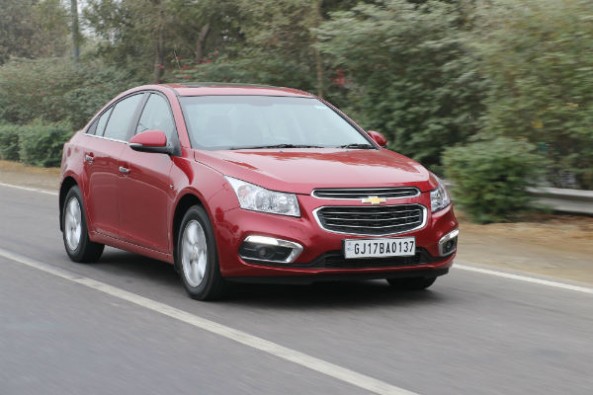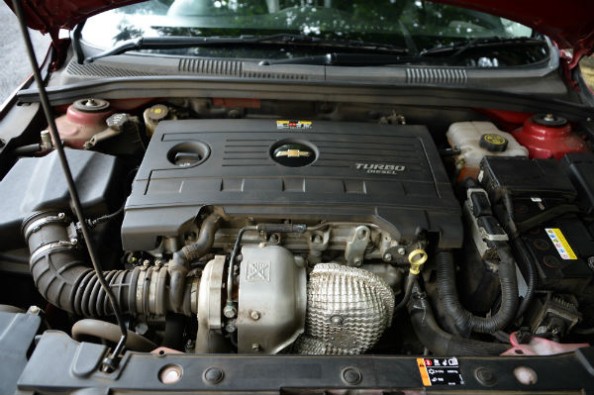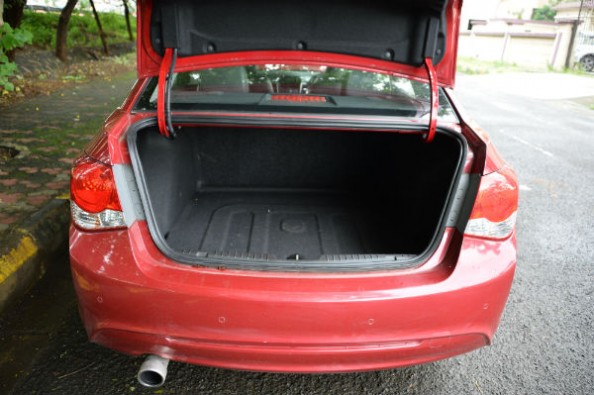This mid-life-cycle update of Chevrolet’s popular sedan comes with improvements mostly on the mechanicals front, including a new powerplant. Why the new engine? It’s because GM globally replaced the previous VM Motoring-developed diesel with its latest ‘Family Z’ unit. This car comes with an all-new six-speed manual gearbox, which replaces the five-speed unit of the earlier car.
Power Torque
The new engine has helped Chevrolet address problems like the massive turbo lag and heavy clutch that plagued the earlier Cruze. This car now makes 166hp, which is a substantial 11 percent more than the old car. Torque has been upped to 380Nm. The Cruze’s new engine sees improvements in the areas of driveability, refinement and fuel efficiency.
You can instantly notice the difference when you start the car up – be it at idle or when you’re revving hard. Its newfound refinement (and power) comes from a host of improvements to the engine’s gut. While the changes have substantially bumped up power and torque, it’s how this car fares in the real world that paints the true picture.
From behindt the wheel
For starters, the new Cruze feels slower initially. But in a good way - there’s a progressive build-up of power, and it’s this far more linear, masking the feeling of speed well. The new car is quicker in most areas though. In the 20-80kph third-gear slog, the new Cruze pips the old model by a half a second, while in the 40-100kph run in fourth gear, it’s quicker by a 1.5 seconds. It’s only when it comes to flat-out acceleration that that the old Cruze is quicker. The new model does the dash to 100kph in 10.22sec, where the old car managed to duck below the 10-second barrier (9.64sec), and at 160kph, the new model is a good two seconds behind. This boils down to the gearing - with an extra gear ratio, better use can be made of the new engine. The new Cruze has pretty short first and second gear ratios for better driveability in traffic. This is something you’ll notice the moment you engage the clutch, which is far lighter now.
At low revs, the engine feels much more responsive and pulls cleanly from below 2000rpm, a point at which the old car would feel like it’s not yet awoken from its slumber. In fact, responsiveness at low speeds and driveability are the improvements you notice immediately. These, along with the light clutch, make the Cruze much more city friendly. On the highway, the new engine comes into its own - the Cruze is a superb cruiser. You’ll enjoy driving this car on the highway. In sixth gear, at 100kph, the engine, turning over at a lazy 1700rpm. The engine is hardly vocal and the surplus of power makes long-distance driving an effortless affair.
The six-speed auto complements the Cruze’s new engine too. Upshifts are relatively quick and acceleration seems effortless. The gearbox isn’t particularly engaging to use though – it is still slow to respond to sharp throttle inputs and is sluggish when you’re trying to work with it too quick. The car’s suspension settings remain unchanged. Straight-line stability, though not as impressive as some of its European rivals, is good and the car feels stable largely. At city speeds though, sharp bumps tend to thud into the cabin, the ride is slightly stiffer and the car crashes through large bumps.
Despite all its power, the Cruze isn’t particularly sporty to drive. The steering is inconsistent and doesn’t weigh up in a linear fashion when you turn into corners. Grip and body control are reasonable though, but when you try to drive this car hard is when you realise it much prefers the straights of the expressway to the twists and turns of a mountain road.
On the inside
Apart from the powertrain changes, the Cruze is largely the same as the previous car. You still get the same sharp styling - the cabin is unchanged too. Hence you get the same additional features like the partially powered driver’s seat and the tweaked seat cushions and headlining to improve headroom at the rear. Back support on the front seats has been softened for better comfort too.
To help improve fuel economy, the gearbox has been programmed to keep moving to a higher gear at the earliest, so you sometimes get upshifts when you don’t want them. The Cruze auto is at its best when you’re cruising or when you’re stuck in choc-o-block traffic. Fuel efficiency is where there is a distinct improvement over the previous model. The manual Cruze returned a decent 10.8kpl in the city and 15.7kpl on the highway as compared to the 10.3kpl and 14.8kpl for the old car. The automatic Cruze returned 9.8kpl and 15.3kpl for city and highway cycles respectively.
Is it worth the money?
The Cruze, with this bump in power, is now further ahead of its rivals in terms of engine output. However, the increase in power has not boosted performance significantly, instead, Chevrolet made the Cruze a more user-friendly car to own and drive. Power is more accessible now owing to a smoother, more responsive engine, and fuel efficiency has improved too. Apart from the slightly claustrophobic interior, the Cruze is hard to fault, and it’s at a price point that undercuts a lot of its direct rivals, making it a great value-for-money buy.









